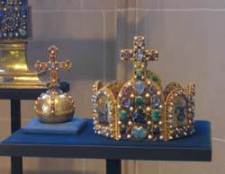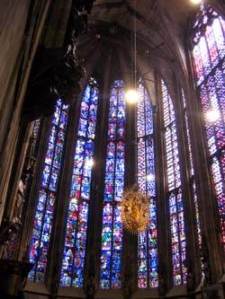|
We didn't have any food for breakfast at the time-share, and we hadn't yet had a chance
to walk around downtown Gemund, so we decided to look for a bakery and some coffee.
We found a bakery where we purchased an apfeltisch, fruit pastry, and vanilla pastry,
but it didn't have coffee for sale, and since we were in a hurry to get going, we skipped the coffee.
This was our last full day in Germany, and we had decided the night before that we wanted to go to Aachen, because of
its famous Dom, Domschatzkammer, and Rathaus. We figured that we only needed about half a day for Aachen, because all of
the sights were close together. The green guide recommended a nearby town called Monschau, and since it was only 30 minutes
from the time-share we decided to stop there on the way to Aachen.
 The directions in the green guide were often extemely vague, and again we had trouble with them. While we were driving, we
could see Monschau below us but couldn't figure out how to get down into the town. We eventually pulled off and parked to take
some pictures of the town from above. After walking a bit along the ridge above the town, we found a long set of stairs that led
down into the town. Unfortunately, by then we were running a bit behind schedule, and since we didn't want to be rushed in Aachen
we decided to continue on.
The directions in the green guide were often extemely vague, and again we had trouble with them. While we were driving, we
could see Monschau below us but couldn't figure out how to get down into the town. We eventually pulled off and parked to take
some pictures of the town from above. After walking a bit along the ridge above the town, we found a long set of stairs that led
down into the town. Unfortunately, by then we were running a bit behind schedule, and since we didn't want to be rushed in Aachen
we decided to continue on.
The only map of Aachen that we had was from the green guide, and it only showed the main roads
and main attractions. Although we were a bit confused as we drove through the city, everything turned out fine because we found
parking in the Buchel parking lot, right near the Dom.
As we were walking to the Dom, we passed an art supply store. We wanted to get some sort of hard cover for the sheet of music that we had
bought for Paul's Dad to protect it from being damaged on our trip home2. We thought the art supply store might have some sort of cardboard or
firm posterboard that we could place on both sides of the sheet of music. The store did have some stiff paper, but we decided to wait until
the end of the day to buy it because we didn't feel like going back to the car or carrying it around with us all day.
 We found the Dom in the middle of M�nsterplatz and decided to walk around the outside before heading in.
Adjacent to the Dom was St. Foillan, a modern looking church that stood in stark contrast to the Dom which was built around 800 A.D.
Even St. Foillan's stained glass windows looked like abstract art. As we continued around the Dom, the Rathaus came into
view across the
Katschhof to the north.
We found the Dom in the middle of M�nsterplatz and decided to walk around the outside before heading in.
Adjacent to the Dom was St. Foillan, a modern looking church that stood in stark contrast to the Dom which was built around 800 A.D.
Even St. Foillan's stained glass windows looked like abstract art. As we continued around the Dom, the Rathaus came into
view across the
Katschhof to the north.
The closeness of the Rathaus in the distance was too enticing, so we decided to go there first. The Rathaus was built in the 14th century on the site of Charlemagne's
palace. The Peace Treaty of 1748, which ended the War of Austrian Succession,
was signed in the Baroque White Room. As the front of the Rathaus came into view, we saw a wedding party preparing
for their imminent wedding.
We walked into the Rathaus and spoke some simple German to the attendant about the entrance fee. After we paid, he continued speaking to us
in German. Realizing that we didn't understand, his companion asked if we spoke English and told us the
Weisser Saal was going to be
used soon for a wedding so we should go there first.
After walking through the Weisser Saal, we headed up the stairs to the top level where artifacts from Charlemagne's reign were displayed.
According to Wikipedia,
"In 800 A.D., at Mass on Christmas
day in Rome, Pope Leo III
crowned Charlemagne Imperator Romanorum (Emperor of the Romans), a title that had been out of use in the West since the abdication of
Romulus Augustulus in
476".
While walking up the stairs, we noticed that the walls were covered in photographs of famous people that we think had
visited the Aachen Rathaus, including the honorable
President Bill Clinton, 42nd President of the USA.
 After leaving the top floor where Charlemagne's crown was on display, we walked through the rest of the
ground floor of the Rathaus. As we left the Rathaus and continued back to the Dom, we saw the wedding party
heading into the Rathaus to begin their ceremony.
After leaving the top floor where Charlemagne's crown was on display, we walked through the rest of the
ground floor of the Rathaus. As we left the Rathaus and continued back to the Dom, we saw the wedding party
heading into the Rathaus to begin their ceremony.
Charlemagne was buried in the Aachen Dom (Charlemagne's Palatine Chapel), which
was built around 800 A.D. From 936 to 1531, the Aachen Cathedral was the church of coronation for 30 kings of the Holy Roman Empire, and
in 1978, it was one of the 12 items to make the initial UNESCO list of world heritage sites.
The initial structure consisted of an octagonal domed central section surrounded by a 16-sided gallery, which was modelled on the
Byzantine palace churches. It was the first construction of this type seen north of the Alps.
 The Aachen Dom is particularly interesting,
because of the very strikingly different architectural styles employed. This original section of the Dom was built
in the Roman style, which is characterized by arches with rounded tops. These were the first types of arches that were invented,
and they are limited in their load bearing properties compared to later more sophisticated arches. Consequently buildings constructed
using Roman arches can only have relatively small windows and are inevitably dark inside. As if to illustrate this very point,
visitors to the Aachen Dom are greeted upon entry with a view of an enormous 12th century chandelier. This chandelier
was donated in 1165 by the Emperor Fredick I Barbarossa.
Passing through the core of the Aachen Cathedral, we arrived in the apella vitrea (glass chapel), which was a Gothic style addition
to the Dom, consecrated in 1414.
In contrast to the Palatine Chapel, the chapel is surrounded by stained glass windows and filled with light.
The enormous stained glass windows were possible because of advances in architecture such as pointed arches and
flying buttresses.
The Aachen Dom is particularly interesting,
because of the very strikingly different architectural styles employed. This original section of the Dom was built
in the Roman style, which is characterized by arches with rounded tops. These were the first types of arches that were invented,
and they are limited in their load bearing properties compared to later more sophisticated arches. Consequently buildings constructed
using Roman arches can only have relatively small windows and are inevitably dark inside. As if to illustrate this very point,
visitors to the Aachen Dom are greeted upon entry with a view of an enormous 12th century chandelier. This chandelier
was donated in 1165 by the Emperor Fredick I Barbarossa.
Passing through the core of the Aachen Cathedral, we arrived in the apella vitrea (glass chapel), which was a Gothic style addition
to the Dom, consecrated in 1414.
In contrast to the Palatine Chapel, the chapel is surrounded by stained glass windows and filled with light.
The enormous stained glass windows were possible because of advances in architecture such as pointed arches and
flying buttresses.
 On our way out of the Dom, we saw a man who looked like he worked there, so we worked up the courage to ask
him in German where the Domshatzkammer was. It must have been obvious that we weren't native speakers, because
he asked "Deutsch or English?". Of course we answered "English", and he told us to go "out the main gate and twenty meters to your right."
On our way out of the Dom, we saw a man who looked like he worked there, so we worked up the courage to ask
him in German where the Domshatzkammer was. It must have been obvious that we weren't native speakers, because
he asked "Deutsch or English?". Of course we answered "English", and he told us to go "out the main gate and twenty meters to your right."
At the Domshatzkammer we bought "A little guide to the Treasury of Aachen Cathedral", which was a 52 page black and white booklet
that had descriptions of all of the major artifacts in the treasury. The treasury had an unbelievable collection of sacral masterpieces
from the late Classical, Carolingian, Ottonian and Staufian period, including the "Cross of Lothair", the "Bust of Charlemagne", the "Persephone sarcophagus"
and numerous relics. The Cross of Lothair was made towards the end of the 10th century and is one of the most valuable objects of remaining medieval goldwork.
The core of the cross consists of oak wood. Its front is made of gold and silver plates richly decorated with precious stones and pearls. The reverse side shows an engraving of Christ on the cross.
The Persophine Sarcophagus is made of marble and dates back to second century Rome. It was transported from Italy to Aachen at Charlemagne's behest
and served as his tomb for about 400 years (until 814 when he was canonized). In the mid-1800's the nude figure on the sarcophagus was felt to be scandalous, so in
1843 an attempt was made to move the sarcophagus to the upper part of the church. The ropes that were used to pull it up
snapped, and the sarcophagus was badly damaged.
The bust of Charlemagne was probably made in Aachen around 1349. It was donated by Charles IV who saw himself as the successor of Charlemagne, and
inside the bust, in the anatomically correct position, the cranium of Charlemagne is preserved. The bust is made of gilded silver, decorated with antiques precious stones.
The bust of Charlamagne was the most prominent example of the many relics in the Aachen Cathedral Treasury. In addition to Charlemagne's
various body parts, the treasury displayed the Virgin Mary's Belt, the belt and flagellation rope of Christ, the arm of St. Simeon, and a part of the sponge Christ was given to drink while hanging on the cross
as well as the remains of various other saints.
Before leaving Aachen, we stopped at a cafe where we ordered a zucchini and cheese panini and a "dijon" sandwich from a young
woman who spoke English very well. We found our way back to the parking garage and drove back to our timeshare. We had some leftover
Chinese food for dinner with a bottle of wine and planned most of our time in Paris before going to bed.
|

